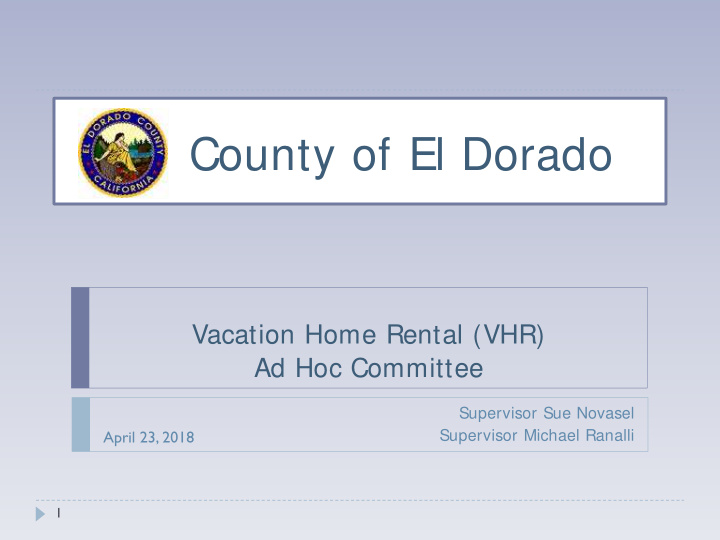



County of El Dorado Vacation Home Rental (VHR) Ad Hoc Committee Supervisor Sue Novasel April 23, 2018 Supervisor Michael Ranalli 1
What is a VHR? Defined in County Ordinance, Chapter 5.56: “Vacation home rental means one or more dwelling units, including either a single-family, home, duplex or single condominium unit rented for the purpose of overnight lodging for a period of not less than one night and not more than 30 days other than ongoing month-to-month tenancy granted to the same renter for the same unit.” Current zoning does not define VHR as commercial activity. 2
VHR Timeline BOS Meeting January 9, 2018 Board declined to impose a moratorium on new VHR permits; Ad Hoc Committee to study the issue and return with recommendations BOS Meeting February 1, 2018 Ordinance revision concepts presented Public input exercise Meeting discontinued prior to public comment and Board discussion Ad Hoc Committee Meeting February 12, 2018 Ordinance concepts presented Results of 2/1/18 exercise presented Public comment (written and oral) BOS Meeting March 13, 2018 Conceptual approval by BOS to proceed with review of VHR functions Ad Hoc Committee Meeting April 12, 2018 Policy/enforcement options exercise regarding issue of noise 3
VHR’s in El Dorado County Unincorporated Area outside of Tahoe Basin: Allowable use of a residence without Conditional Use Permit Business license required Transient Occupancy Tax (TOT) registration certificate required Current number of VHR’s not known with certainty, as no specific permit is required 4
VHR’s in El Dorado County Tahoe Basin: Allowable use of a residence without Conditional Use Permit Business license required Transient Occupancy Tax (TOT) registration certificate required Regulated by County Ordinance Code Chapter 5.56 VHR Permit required About 822 active permits 5
Current VHR Ordinance Applies only to unincorporated area in Tahoe Basin Seeks to balance benefits of VHR’s with their impacts on neighborhoods and public services Limits occupancy Limits parking Requires “Local Contact Person” Requires notification to occupants of VHR’s regarding local laws relating to solid waste, noise, etc. Sets forth monetary penalties for violations 6
Conceptual Ordinance Revisions Restructure Violation and Penalty Provisions No warnings Increase penalties Current: Warning, $250, $500 within 12 month period Recommended: $500, $1,000, $1,500 within 18 month period Focus on nuisance behavior Clarify Language throughout Ordinance Reduce subjectivity (for example, use of “best efforts”) Establish clear expectations 7
Conceptual Ordinance Revisions Require Exterior Signage Local Contact information (for use by neighbors) Permit number Minimum size and font requirements Cap Number of Occupants during Quiet Hours May not exceed permitted number of occupants between 10:00 p.m. and 8:00 a.m. 8
Conceptual Ordinance Revisions Apply Ordinance Countywide Begin regulating new and existing VHR’s outside Tahoe Basin Grace period for VHR’s with current business licenses to comply Require Inspections prior to Permit Issuance Compliance with ordinance and permit conditions Health and safety concerns 9
Conceptual Ordinance Revisions Review County VHR Functions (approved 3.13.18) Align responsibilities for permitting, inspection, compliance, and enforcement appropriately within County organization Consider use of technology and contracted services Cost recovery Bear-Proof Trash Receptacles Link to revised Public Health and Safety ordinance language 10
VHR Ad Hoc Committee Supervisors Novasel (District V) and Ranalli (District IV) designated by Board of Supervisors Goal: Modernized policies and enforcement methods that retain the benefits of VHR’s, prevent or mitigate their impact on neighborhoods, and minimize their impact on public services Objectives: Improve neighborhood compatibility Avoid overconcentration of VHR’s and commercialization of neighborhoods 11
• Noise after 10pm • Car doors slamming Noise • Loud Music • Yelling and Loud Voices • Speeding • Parking illegally • Traffic congestion Parking/Traffic • Obstructing driveways Improve • Fireworks Neighborhood Safety • Fire Compatibility • Unsafe structures • Walking through property • Sleeping on Trespassing property • picnics • Bear boxes Trash • Litter 12
Discussion Framework For each issue: Policy Options Pros Cons Enforcement Options Pros Cons 13
Public Input 14
Cities/Counties for Comparison How are other jurisdictions addressing VHRs? Chosen for geographical/population/other similarities and tourist industry The List: Napa County Mendocino County County of Sonoma Douglas County, NV Monterey County City of South Lake Tahoe County of Riverside City of Palm Springs Santa Barbara County City of Palm Desert Marin County City of Napa San Luis Obispo County City of Healdsburg Placer County City of Santa Barbara Mono County 15
Meeting Schedule 16
Questions? 17
Recommend
More recommend